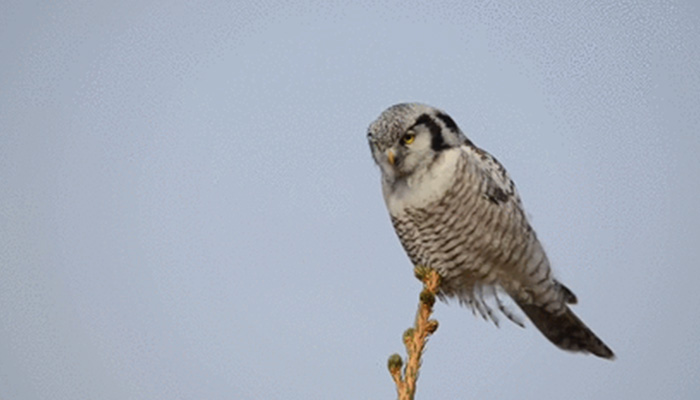
English: Northern Hawk Owl, Hawk Owl
Russian: Ястребиная сова
Mongolian: Харсуун бэгбаатар, Харсуун ууль
German: Sperbereule
French: Chouette eperviere
Japanese: オナガフクロウ (Onaga-fukuro)
Body length: 35-43 cm
Wing span: 69-82 cm
Mainly resident in boreal forests, often in upper tree
zone on mountain slopes (mixed conifers and birch), preferring vicinity of bog,
meadow or clearfell. Fluctuating
in numbers, some years locally fairly common. In some autumns considerable
numbers move south. About five records in Britain in 20th century.
Partly diurnal. Food voles (main prey, taken on ground after watch from
treetop) and birds (e.g. thrushes; capable of catching prey as large as Willow
Grouse). Nests in tree-holes (‘chimney’ or vertical) or abandoned raptor’s
nest. Caution: Can fiercely attack intruders when young leave nest; do not go
near, and keep your eyes fixed on the parents while in sight of young just out
of a nest!
Identification: Medium-sized with
distinctive proportions: very long tail and rather narrow, bluntly pointed
wings, thus recalling a hawk more than other owls, this enhanced by direct,
agile flight with short series of wingbeats relieved by brief glides. Perches
in treetops, also fearlessly exposed in bare dead spruces. Head rather large
and often flat-crowned (alert, alarmed). Upperparts dark brown with pale
hind-neck and scapulars, latter forming prominent V on perched bird in rear
view (‘braces’). Underparts whitish and finely cross-barred except on upper
breast, which is pure white. Face whitish, strongly outlined black, expression
‘stern’. Eyes yellow. Nape has a pale and dark pattern (‘false face’, defence
purpose), and side of head has a black patch. Juvenile: Similar to adult but a
little greyer and duller, with dusky eye-surround and diffusely patterned
throad and upper breast.